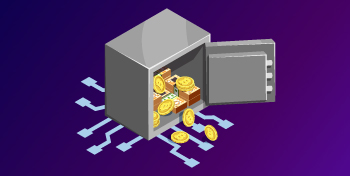In recent months, staking has become quite popular in the industry and attracts more and more followers. Let’s see how this system works and what its limitations are.
What is staking and what are its features
In an analytical report published on October 28, Binance Research explains how staking works and its features. The document describes in detail, in particular, several projects that offer such technology, while highlighting the potential risks of this type of investment.
Binance Research defines staking as follows:
“Staking is the process of storing funds in a crypto wallet to support the operation of the blockchain network. This essentially involves blocking crypto assets in order to receive rewards”.
Projects use staking as a method of encouraging users to participate in the functioning of the blockchain. First of all, users are interested in finding profit. Basically, the placement fee is associated with cryptocurrencies with a certain volatility, and this can be risky for the investor.
The concept of staking is directly related to the Proof of Stake (PoS) consensus, and its variations are currently available on the market. The main goal of this consensus Protocol is to significantly reduce the energy costs associated with maintaining its blockchain, while providing acceptable security and improved scalability. Binance Research defines Proof of Stake as:
“An algorithm that uses a pseudo-random selection process to designate a node as the next block validator, based on a combination of factors that include stack time, node prosperity, and randomness”.
More and more projects are using this consensus, but some have created their own version of PoS by adding or changing some of Its features. This is seen in the case of Proof of Stake (PoSv) Tomochain (TOMO) and Delegated Proof of Stake (DPoS) voting used by EOS.
The Ethereum blockchain currently operates in Proof of Work (PoW), but plans to switch to consensus PoS soon to improve its scalability and allow the launch of ETN staking while remaining effective in the market.
Responsibilities and restrictions of participants

For those who want to fully invest in staking and become a full-fledged node of the network, there are rules and restrictions, so everyone can get access to staking. These responsibilities and restrictions are therefore exclusive to node owners.
- Management
In the case of some blockchains, obtaining the right to participate in the management process can be a real burden for participants. For example, a participant (validator) may need to communicate with other node owners to develop standards and best practices for the entire blockchain, participate in management teleconferences, and participate in online forum discussions. Anonymity can be maintained, but the owner of a node that does not integrate into the community will have difficulties.
- Become a node and maintain it
The process of obtaining the status of a blockchain node may require significant costs. Depending on the project, there may be an application form, a registration fee, and a security Deposit that future validators must make before they can deploy their node.
- Technical aspect
Node operators are usually required to maintain constant availability. In some cases, failure to comply with these requirements may also result in penalties.
Running a node usually requires special security measures, which can cost more than the computing resources themselves. If an operator decides to manage their node locally, for example, they will have to configure their own security using a VPN, a powerful firewall, private connections, and so on.
Starting a full node is not available to everyone, both from a financial and technical point of view. Fortunately for us, the door to staking does not close on this, and ordinary users can take advantage of other opportunities. However, staking also has its own risks and limitations.
Risks and limitations of staking

As with any other type of investment, especially in the world of cryptocurrencies, you need to know the limits and risks. The dangers of staking are not very numerous, but they strongly affect the rewards.
- Security risks
Staking in some blockchains requires funds to be stored in a crypto wallet, which itself is hosted on the same computer that the node is running on. This is a potential source of security concerns for users who want to keep their funds in a cold wallet. Other blockchains require frequent actions with funds, which once again prevents the complete storage of crypto assets outside the network.
- The uncertainty of interest rates
In the case of some cryptocurrencies, the percentage of staking rewards varies depending on many factors. This applies when rewards are distributed between staking pools. Indeed, depending on the number of tokens blocked in the network and the rating of the pool among competitors, the percentage of charges that you will receive may fluctuate greatly.
More generally, the greater the number of participants in the block chain offering stacking, the more the reward received by each user decreases. In addition, projects can also conduct marketing events that only last a certain amount of time to attract new users. Therefore, this can greatly change the percentage of rewards.
The main factor that determines the amount that a user will receive for participating in the network is the time when their assets are blocked. Therefore, in order to maximize your profits, you need to lock up your assets for as long as possible. This may indirectly prevent certain rational decisions from being made in the event of a General market downturn.
- The uncertainty of price
The most obvious risk associated with stacking, and of course with trading in General, is price uncertainty. Indeed, if the price of an asset falls by a higher percentage than the revenue from the reward itself, your contribution to the block chain will bring you nothing but headaches and will not compensate for your losses.
The increasing availability

Despite the apparent complexity of staking, those who want to invest in this sector have several options. Indeed, there are many ways to delegate your coins, but the types of services provided to users can be quite different. Let’s focus on the most used ones today.
- Pools for staking
A group of users, more commonly known as a staking pool, allows multiple people to combine their capabilities to increase their chances of getting rewarded.
As a rule, staking pools work specifically with one cryptocurrency, such as mining pools. This is usually one of the easiest ways to start participating in staking, and get a part of the reward, in proportion to the participation of each person.
Most pools in the market charge a fee which reduces the final reward received by participants. However, the main advantage of this option is that passive income is guaranteed, and users do not need any technical knowledge or additional financial investments. In addition, they will not have to worry about node maintenance and competition between pools.
- Exchange platform
There are new players on the exchanges that are sure to overshadow the staking pools. The list of the latter offering such a service is growing rapidly and includes Binance, Coinbase, Huobi, Poloniex and OKEx. Each platform, of course, has its own characteristics, but the overall work remains unchanged.
- Mobile crypto wallets
This option is by far the easiest to use, and also allows the user not to block their funds if they want to participate in staking. Although the user delegates their coins to staking, their funds remain in their wallet.
The fact that crypto wallets offer staking is a real opportunity for cryptocurrency project teams. Thanks to this innovation, projects provide more active participation in their activities. In theory, this also allows prices to rise, because staking technology promotes long-term investment. This is potentially not in the interests of some cryptocurrency holders, who immediately sell coins at the slightest movement of the price down.
The effect of accepting staking gives crypto resources real visibility and, in particular, allows you to develop an ecosystem that is interesting for projects and more attractive to investors. When the platform offers this option, it also guarantees that the user’s funds will remain there, and will benefit them in the long run. Thus, there is a lot of interest in platforms, and this partly explains why the addition of staking is happening so quickly.
Conclusion
Since crypto resources offer their users staking options, everything has become much easier and more accessible for everyone. This investment alternative, previously intended for a certain class of investors, brings a breath of fresh air to such an unpredictable market.
If you are interested in these investments, don’t just focus on the gross profit that the project offers you. As we saw earlier, staking involves some risks, and some cryptocurrencies are better at avoiding this than others. Therefore, you will need to take into account the elements so that you can find the asset that suits you: the consensus protocol used, the total percentage of blocked tokens, the project history, its risk management, and the responsibilities and rights of participants.
Staking, which is now considered one of the best alternatives to trading for passive income, can bring you substantial income. With the upcoming migration of the Ethereum blockchain to Proof of Stake, staking can become the center of everyone’s attention and the door to any type of investment.


